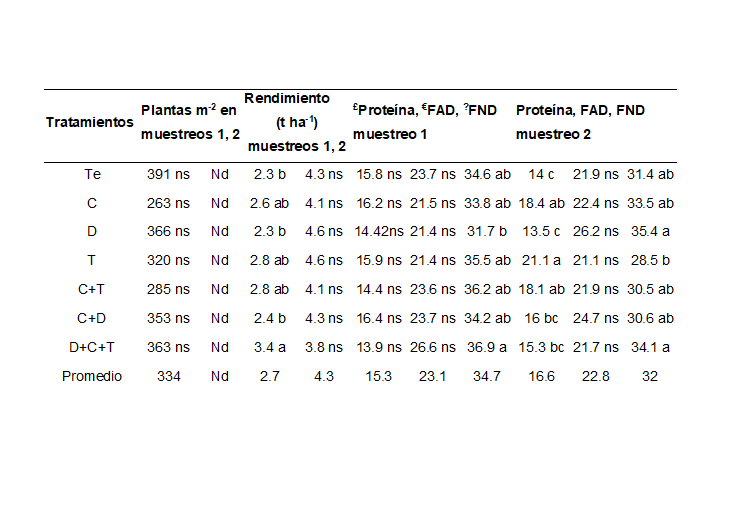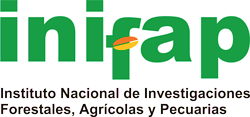Evaluación de Trichoderma spp., desinfestación y cincelado del suelo en alfalfa
DOI:
https://doi.org/10.29312/remexca.v16i5.3082Palabras clave:
endófitos, enfermedades, forrajes, hongosResumen
El cultivo de alfalfa Medicago sativa L. lo limita las pudriciones de la corona (Rhizoctonia solani) y texana (Phymatotrichopsis omnivora), la salinidad y la compactación del suelo. Para atenuar las pudriciones del cultivo, los objetivos fueron a nivel de laboratorio evaluar métodos de inoculación de Trichoderma spp., en semilla de alfalfa y en campo, evaluar parámetros agronómicos y pudriciones de la corona y texana, después de inocular la semilla con T. harzianum (T) cincelado profundo del suelo (C) y desinfestación reductiva del suelo (D), las combinaciones C+T, C+D, D+C+T y como testigo (Te) semilla sin inocular y suelo sin tratar. Placas (PDA) de T. harzianum de 1, 2, 4, 8 y 10 d de crecimiento se utilizaron para colocar semillas de alfalfa previamente germinadas (Sg) o sin germinar (Sng), después de 17 d, el tamaño y supervivencia de las plántulas de Sng fue mayor a sus correspondientes Sg (Tukey p< 0.05). En el campo, el peso y tamaño de plantas de D+C+T vs Te fueron entre (27-35) y (9-3)% mayor, respectivamente, pero sin significancia estadística. Únicamente en un primer muestreo, se detectó un 30% más rendimiento de D+C+T con respecto al Te (Tukey p= 0.05). La calidad, rendimiento y plantas por m2 de la alfalfa fue similar a lo previamente reportado.
Descargas
Citas
Bilal, S.; Shahzad, R.; Imran, M.; Jan, R.; Kim, K. M. and Lee, I. J. 2020. Synergistic association of endophytic fungi enhances Glycine max L. resilience to combined abiotic stresses: Heavy metals, high temperature and drought stress. Industrial Crops and Products. 143:1-10. https://doi.org/10.1016/j.indcrop.2019.111931.
Bonanomi, G.; Antignani, V.; Pane, C. and Scala, F. 2007. Suppression of soilborne fungal diseases with organic amendments. Journal of Plant Pathology. 89(3):311-324. https://www.jstor.org/stable/41998409.
Chavez, H. B.; Bloss, H. E.; Boyle, A. M. and Gries, G. A. 1976. Effects of crop residues in soil on Phymatotrichum root rot of cotton. Mycopathologia. 58(1):1-7. https://link.springer.com/article/10.1007/BF00493585.
Chew-Madinaveitia, Y. y Samaniego-Gaxiola, J. A. 2007. Tratamiento a la semilla de alfalfa Medicago sativa L. con Trichoderma sp. para el manejo de Rhizoctonia solani y Fusarium spp. Agrofaz. 7(1):51-56. http://agrofaz.net/index.php/agrofaz.
Chew-Madinaveitia, Y. and Santamaría-César, J. 2000. Estimation of losses caused by crown rot of alfalfa Medicago sativa L. in the Comarca Lagunera North of Mexico. ITEA. Información Técnica Económica Agraria. 96(3):165-172. https://www.aida-itea.org/aida-itea/files/itea/revistas/2000/96V-3/96V-3-02.pdf.
Figueiredo dos Santo, L.; Fernandes-Souta, J.; Paula-Soares, C.; Oliveira-Rocha, L.; Luiza, Carvalho-Santos, M.; Grativol-Gaspar, C.; Fernando-Wurdig, R. L. and Lopes-Olivares, F. 2021. Insights into the structure and role of seed-borne bacteriome during maize germination. FEMS Microbiology Ecology. 97(4):1-13. http://orcid.org/0000-0001-6541-0324.
Harman, G. E.; Doni, F.; Khadka, R. B. and Uphoff, N. 2021. Endophytic strains of Trichoderma increase plants' photosynthetic capability. Journal of applied microbiology. 130(2):529-546. https://doi.org/10.1111/jam.14368.
Kasuya, M.; Olivier, A. R.; Ota, Y.; Tojo, M.; Honjo, H. and Fukui, R. 2006. Induction of soil suppressiveness against Rhizoctonia solani by incorporation of dried plant residues into soil. Phytopathology. 96(12):1372-1379. https://doi.org/10.1094/PHYTO-96-1372.
Lara-Macías, C. R. y Jurado-Guerra, P. 2014. Paquete tecnológico para producir alfalfa en el estado de Chihuahua. Centro de Investigación Regional Norte Centro- Instituto Nacional de Investigaciones Forestales, Agrícolas y Pecuarias (INIFAP). Chihuahua, México. Folleto técnico núm. 52. 48 p. https://www.producechihuahua.org/paqs/PT-0010Alfalfa.pdf.
Lata, R.; Chowdhury, S.; Gond, S. K. and White, J. F. 2018. Induction of abiotic stress tolerance in plants by endophytic microbes. Letters in applied microbiology. 66(4):268-276. https://sfamjournals.onlinelibrary.wiley.com/doi/full/10.1111/lam.12855.
Mayer, K. M. 2002. Impact of nitrogen management strategies on yield, N-use efficiency, and Rhizoctonia diseases of Irish potato. A thesis North Carolina State University Master of Science. 90 p. https://repository.lib.ncsu.edu/bitstream/handle/1840.16/113/etd.pdf?sequence=1&isAllowed=y.
Moin, S.; Rahman, A.; Parveen, G.; Korejo, F.; Shafique, H. A.; Zehra, R. and Ehteshamul-Haque, S. 2021. Amelioration of systemic resistance in tomato against root rotting fungi by the endophytic Trichoderma species. Pakistan Journal of Botany. 53(1):321-327. http://www.pakbs.org/pjbot/papers/1610615318.pdf.
Morán-Diez, M. E.; Martínez-Alba, Á. E.; Rubio, M. B.; Hermosa, R. and Monte, E. 2021. Trichoderma and the plant heritable priming responses. Journal of Fungi. 7(4):318-341. https://www.mdpi.com/2309-608X/7/4/318/pdf.
Mukhopadhyay, A. N.; Shrestha, S. M. and Mukherjee, P. K. 1992. Biological seed treatment for control of soil-borne plant pathogens. Boletín Fitosanitario de la FAO. 21-32 pp. https://agris.fao.org/agris-search/search.do?recordID=XF9432035.
Núñez, H. G. 2000. Valor nutritivo de la alfalfa. In: producción y utilización de la alfalfa en la zona norte de México. INIFAP. Matamoros, Coahuila, México. Libro técnico núm. 2. 93-102 pp. http://www.inifap-nortecentro.gob.mx/include/container-usuario.php.
Papavizas, G. C.; Adams, P. B.; Lumsden, R. D.; Lewis, J. A.; Dow, R. L.; Ayers, W. A. and Kantzes, J. G. 1975. Ecology and epidemiology of Rhizoctonia solani in field soil. Phytopathology. 65(8):871-877. https://www.apsnet.org/publications/phytopathology/backissues/Documents/1975Articles/Phyto65n08-871.pdf.
Redman, R. S.; Kim, Y. O.; Cho, S.; Mercer, M.; Rienstra, M.; Manglona, R. and Rodriguez, R. J. 2021. A Symbiotic approach to generating stress tolerant crops. Microorganisms. 9(5):920-947. https://www.mdpi.com/2076-2607/9/5/920/pdf.
Rohweder, D.; Barnes, R. F. and Jorgensen, N. 1978. Proposed hay grading standards based on laboratory analyses for evaluating quality. Journal of Animal Science. 47(3):747-759. https://doi.org/10.2527/jas1978.473747x.
Rokni, N.; Alizadeh, H. S.; Bazgir, E.; Darvishnia, M. and Mirzaei-Najafgholi, H. 2021. The tripartite consortium of Serendipita indica, Trichoderma simmonsii, and bell pepper (Capsicum annum). Biological Control. 158(7):1-12. https://doi.org/10.1016/j.biocontrol.2021.104608.
Rush, C. M. and Lyda, S. D. 1984. Evaluation of deep-chiseled anhydrous ammonia as a control root for Phymatotrichum root rot of cotton. Plant Disease. 68(4):291-293. https://www.apsnet.org/publications/plantdisease/backissues/documents/1984articles/plantdisease68n04291.pdf.
Samaniego-Gaxiola, J. A. y Escobedo-Gámez, I. A. 2000. Evaluación de residuos para mantener la sanidad de semillas inoculadas con Trichoderma sp. en suelo infestado con Rhizoctonia solani. Revista Mexicana de Fitopatología. 18(2):71-78. https://www.redalyc.org/articulo.oa?id=61218201.
Samaniego-Gaxiola J. A.; Pedroza-Sandoval, A.; Chew-Madinaveitia, Y. y Gaytán-Mascorro, A. 2019 a. Reductive disinfestation, soil desiccation and Trichoderma harzianum to control Phymatotrichopsis omnivora in pecan tree nursery. Revista Mexicana de Fitopatología. 37(2):287-303. https://doi.org/10.18781/r.mex.fit.1808-7.
Samaniego-Gaxiola, J. A.; Chew-Madinaveitia, Y.; Gaytán-Mascorro, A. y Pedroza-Sandoval, A. 2019b. Biological, anaerobic and reductive soil disinfestation to the soil for control of harmful organisms to plants. Revista Mexicana de Fitopatología. 37(1):115-134. https://doi.org/10.18781/r.mex.fit.1810-1.
Samaniego-Gaxiola, J. A.; Chew-Madinaveitia, Y. y Gaytán-Mascorro, A. 2021. Comportamiento del melón inoculado con Trichoderma harzianum. In: memorias XXXIII Semana Internacional de Agronomía. Vencia, Durango, México. 25-29 pp. https://sci-platform.org/siaxxxiii/.
SAS Institute Inc. 2000. The SAS system for windows version 9.0. North Carolina. SAS Institute Inc. Cary.
Shen, J.; Li, C.; Mi, G.; Li, L.; Yuan, L.; Jiang, R. and Zhang, F. 2013. Maximizing root/rhizosphere efficiency to improve crop productivity and nutrient use efficiency in intensive agriculture of China. Journal of Experimental Botany. 64(5):1181-1192. https://doi.org/10.1093/jxb/ers342.
SIAP. 2020. Sistema de Información Agroalimentaria y Pesquera. Servicio de Información Estadística Agroalimentaria y Pesquera. http://infosiap.siap.gob.mx/gobmx/datosAbiertos/ProduccionAgricola/Cierre-agricola-mun-2019.csv.
Schweiger, R.; Padilla-Arizmendi, F.; Nogueira-Lopez, G.; Rostás, M.; Lawry, R.; Brown, C. and Mendoza-Mendoza, A. 2021. Insights into metabolic changes caused by the Trichoderma virens-maize root interaction. Molecular Plant-Microbe Interactions. 34(5):524-537. https://apsjournals.apsnet.org/doi/pdfplus/10.1094/MPMI-04-20-0081-R.
Stewart, A. and Hill, R. 2014. Chapter 31. Applications of Trichoderma in plant growth promotion. Biotechnology and biology of Trichoderma. Elsevier. 415-428 pp. https://doi.org/10.1016/B978-0-444-59576-8.00031-X.
Vázquez-Vázquez, C.; García-Hernández, J. L.; Salazar-Sosa, E.; Murillo-Amador, B.; Orona-Castillo, I.; Zúñiga-Tarango, R.; Rueda-Puente, E. O. y Preciado-Rangel, P. 2010. Rendimiento y valor nutritivo de forraje de alfalfa (Medicago sativa L.) con diferentes dosis de estiércol bovino. Revista Mexicana de Ciencias Pecuarias. 1(4):363-372. http://www.scielo.org.mx/pdf/rmcp/v1n4/v1n4a5.pdf.
Zhang, Z. and Peng, X. 2021. Bio-tillage: a new perspective for sustainable agriculture. Soil and Tillage Research. 206(2):1-9. https://www.sciencedirect.com/science/article/pii/S0167198720306267.

Descargas
Publicado
Cómo citar
Número
Sección
Licencia
Derechos de autor 2025 Revista Mexicana de Ciencias Agrícolas

Esta obra está bajo una licencia internacional Creative Commons Atribución-NoComercial 4.0.
Los autores(as) que publiquen en Revista Mexicana de Ciencias Agrícolas aceptan las siguientes condiciones:
De acuerdo con la legislación de derechos de autor, Revista Mexicana de Ciencias Agrícolas reconoce y respeta el derecho moral de los autores(as), así como la titularidad del derecho patrimonial, el cual será cedido a la revista para su difusión en acceso abierto.
Los autores(as) deben de pagar una cuota por recepción de artículos antes de pasar por dictamen editorial. En caso de que la colaboración sea aceptada, el autor debe de parar la traducción de su texto al inglés.
Todos los textos publicados por Revista Mexicana de Ciencias Agrícolas -sin excepción- se distribuyen amparados bajo la licencia Creative Commons 4.0 atribución-no comercial (CC BY-NC 4.0 internacional), que permite a terceros utilizar lo publicado siempre que mencionen la autoría del trabajo y a la primera publicación en esta revista.
Los autores/as pueden realizar otros acuerdos contractuales independientes y adicionales para la distribución no exclusiva de la versión del artículo publicado en Revista Mexicana de Ciencias Agrícolas (por ejemplo incluirlo en un repositorio institucional o darlo a conocer en otros medios en papel o electrónicos) siempre que indique clara y explícitamente que el trabajo se publicó por primera vez en Revista Mexicana de Ciencias Agrícolas.
Para todo lo anterior, los autores(as) deben remitir el formato de carta-cesión de la propiedad de los derechos de la primera publicación debidamente requisitado y firmado por los autores(as). Este formato debe ser remitido en archivo PDF al correo: revista_atm@yahoo.com.mx; revistaagricola@inifap.gob.mx.
Esta obra está bajo una licencia de Creative Commons Reconocimiento-No Comercial 4.0 Internacional.


